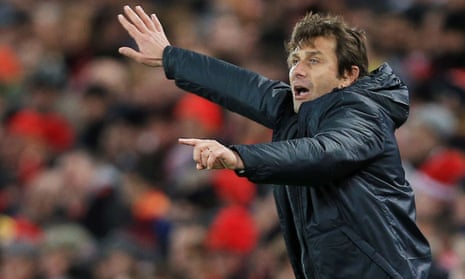To stand still, as Peter Reid once observed, is to move backwards. There is need for permanent revolution, constantly to be battling the twin demons of familiarity and complacency, stimulating your own players while preventing your opponents ever being quite sure what you will do next. No team can ever rely on one tactic forever: a withdrawn winger won Alf Ramsey’s Ipswich the league in 1962; it almost got them relegated once everybody had worked it out a year later.
Chelsea’s title triumph last season was rooted in the 3-4-2-1 to which Antonio Conte switched after the defeat at Arsenal. Opponents struggled to break down the block of three central defenders screened by two midfield holders and they struggled to deal with two inside forwards floating in the pockets outside their own holding players but inside the full-back. The change of shape was so devastating it brought 13 wins in a row, but even by the end of the season, teams had begun to work out ways of countering it, largely by mirroring shape for shape.
So perhaps it is understandable that Conte should look to move on, that he should tweak and develop the system. Anfield on Saturday was the third time this season in the league that he has preferred a 3-5-1-1 to the 3-4-2-1. He did it away to Tottenham, when N’Golo Kanté, David Luiz and Tiémoué Bakayoko provided a platform for Willian, and he did it at home to Manchester City, when Hazard played in front of Kanté, Bakayoko and Cesc Fàbregas. On Saturday it was Hazard playing in front of Kanté, Bakayoko and Danny Drinkwater.
Fairly clearly, Conte sees it as a system to be deployed against other top sides. A six-man central block is hard to play through for anybody; City produced one of their best performances of the season at Stamford Bridge and yet were restricted to a single goal. Philippe Coutinho was repeatedly crowded out on Saturday. But whatever the benefits of the shape in that regard, there are clear drawbacks.
The advantage of the 3-4-2-1 is that it offers both stability and two players who have the freedom to take up unusual positions, probing for weaknesses. Pulling back one of the inside-forwards places a huge creative responsibility on the one who is left. Eden Hazard thrived in the first half on Saturday, supported occasionally by the forward surges of Marcos Alonso on the left and Drinkwater’s runs from deep. But in the second half, once James Milner and Jordan Henderson had got themselves sorted out, Hazard was largely anonymous until support arrived from the bench in Pedro and Willian.
Not only that, but requiring Alonso to get forward so frequently – and he is highly effective at that, as was demonstrated by his winner against Tottenham – poses defensive problems. Three times in the first half simple one-twos created crossing opportunities for Mohamed Salah as he got into the space behind the left wing-back, while for much of that opening period he was able to attack Gary Cahill on the left of Chelsea’s three central defenders. That in turn was partly the result of the lack of cover offered by Bakayoko, whose adaptation to the Premier League has not been straightforward. Jürgen Klopp closed down that game of chicken at half-time, switching Salah to the left so Alex Oxlade-Chamberlain could move to the right and track Alonso, meaning both sides looked less threatening on that flank.
By the end it seemed strange it had been played at all. As Conte switched through the gears, bringing on Fàbregas, then Pedro, then Willian, Chelsea became more and more threatening. All those defensive neuroses Liverpool have built up over the last few seasons were exposed again. Every ball in the box caused panic.
The equaliser may have been fortunate but it was not unexpected. That it was only the second goal Liverpool have conceded at home this season is baffling. The message was clear: attack them and they will crumble. Conte was not as cautious as José Mourinho and Manchester United had been here but the ultimate question was the same: by not being ruthless in going for Liverpool’s vulnerabilities, had a title challenger rather needlessly given away two points?

Comments (…)
Sign in or create your Guardian account to join the discussion